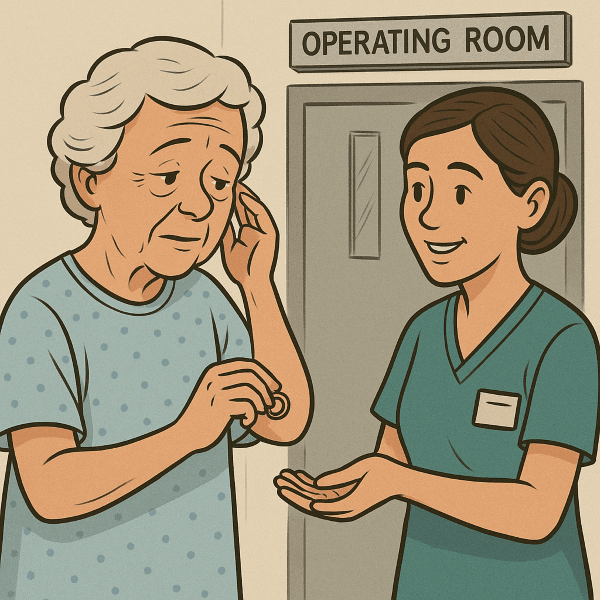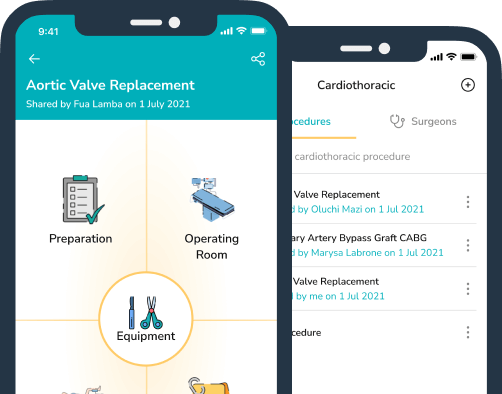Jewellery, Piercings & Metal in the Operating Room – The Hidden Burn Risk
Posted at 12 August 2025 in Healthcare Safety,Perioperative Nursing,Surgical Best Practice by Marrianne
Why This Matters
Electrosurgical units (ESUs)—both monopolar and bipolar—are essential to modern surgery, but they carry the risk of burn injuries when electricity strays from its intended path. Metal items—such as jewellery, piercings (including tongue and genital), or internal implants—can potentially become unintended pathways. This post highlights how to mitigate those risks, why it matters for patient safety, and the financial consequences for hospitals.
The Numbers – Global Perspective
Electrosurgical burns are rare but costly:
-
Canada: 53 reported cases over five years involving OR burns or fires, nearly half linked to electrosurgery.
-
USA: State safety data reveal over 50% of ESU-related incidents involve burns, often due to accidental activation or poor return pad contact.
-
UK: ~80 electrosurgical burn incidents annually, with ~35% involving grounding pad issues.
-
Australia: Fewer published stats—but repeated safety alerts highlighting risks like instrument insulation failure underscore ongoing concerns.
Globally, 2–5 electrosurgical burns per 1,000 laparoscopic procedures translate to thousands affected yearly across high-volume health systems.
Jewellery & Piercings – Myth vs. Reality
Modern studies—including one in JAMA Surgery—show that most jewellery and piercings don’t cause burns when the ESU system is functioning properly. Electricity prefers the low-resistance return pad over small metal objects covered by drapes.
But caution remains necessary. In rare cases of pad failure or equipment malfunction, any metal can become a hazard.
When Risk Increases
The danger spikes when metal is very close to the surgical site or in a high-risk combo:
-
Tongue Piercings: During oral surgery (e.g., tonsillectomy), having a metal tongue bar plus cautery and supplemental oxygen presents a notable risk of alternate-site burn or fire. Tongue jewellery should always be removed pre-op.
-
Genital Piercings: Piercings near operative sites (e.g., groin, perineal, or urological procedures) similarly elevate burn risk; removal and patient awareness are essential.
Why Nurses Tape Rings and Secure Piercings
When a ring or piercing cannot be removed—due to swelling, embedded design, cultural significance, or patient refusal—nurses will often tape over the item.
This is not done to prevent electrical conduction (tape doesn’t insulate against electrosurgery current) but to:
-
Prevent mechanical injury – Jewellery can scratch or tear surgical gloves, drapes, or delicate equipment insulation.
-
Avoid snagging – Metal can catch on surgical gowns, patient positioning devices, or instrument cables.
-
Protect from loss or damage – Taping secures the jewellery in place during patient transfer or positioning.
This practice is a secondary safety measure, not a substitute for removal. Whenever possible, jewellery and piercings should be fully removed before surgery to eliminate risk.
Internal Metal Implants
Although theoretically concerning, no documented burns have occurred due to internal hip or knee implants in recent years. However, grounding pads must never be placed over or near implants, as soft tissue routes are vastly safer for current flow.
The Real Culprits Behind ESU Burns
Far more common causes include:
-
Poor return pad adhesion
-
Damaged instrument insulation
-
Contact with conductive OR fixtures
-
Accidental activation when the active electrode rests on drapes or the patient
Financial Cost to Hospitals
Burn incidents from electrosurgery aren’t just patient safety issues—they carry significant financial burdens:
-
General surgical complications increase hospital costs by nearly $19,600 per case, while reducing profit margins to nearly zero compared to uncomplicated surgeries.
-
Burn-specific care is especially resource-intensive:
-
Average total cost per burn patient in the U.S.: $51,770, with daily costs averaging $8,845.
-
Severe burns can range from $300,000–$500,000 per patient.
-
Hospital stays for burn-related injuries average $24,000, double the cost of typical admissions.
-
In the U.S., burn-related hospital costs exceed $1 billion annually—about 1% of all hospital spending.
-
Preventing even a handful of ESU burns annually can translate into significant cost savings and reduced patient harm.
Standards of Practice – Minimizing Risk and Cost
To protect patients—and hospital resources—adhere to these best practices:
-
Remove all jewellery and piercings, including tongue and genital ones, especially if near the surgical field.
-
Patient education: Clearly communicate burn risks from piercings and implants as part of consent.
-
If jewellery cannot be removed, tape to secure and protect from mechanical harm—but never rely on tape for electrical safety.
-
Position grounding pads away from piercings or metal implants.
-
If the incision is close to metal, consider using bipolar electrosurgery instead of monopolar — this is safer and reduces current spread.
-
Inspect instruments for intact insulation before use.
-
Holster the active electrode when not in use; never leave it on drapes or patient.
-
Prevent patient contact with grounded surfaces.
-
Use lowest effective power, shortest activation bursts.
-
Allow surgical prep to fully dry, preventing fires and burns.
Takeaway for the Surgical Team
Jewellery and piercings are rarely direct causes of electrosurgical burns—but eliminating even the slightest risk helps protect patients and hospitals. Burn care is complex, costly, and emotionally taxing. Preventing ESU burns through vigilance and best practices safeguards both human and financial health.
References
-
Blumenstein N, et al. Bringing to Light the Risk of Burns From Retained Metal Jewelry Piercings in the Operating Room – Torching the Myth. JAMA Surgery. 2022. https://jamanetwork.com/journals/jamasurgery/article-abstract/2789491
-
Calder LA, et al. Surgical Fires and Burns: A 5-Year Analysis of Medico-Legal Cases in Canada. J Burn Care Res. 2019;40(6):744–750. https://pubmed.ncbi.nlm.nih.gov/30562214/
-
Vilos GA, et al. Understanding and Practising Safe Electrosurgery in the Operating Room. J Obstet Gynaecol Can. 2018;40(3):e207–e222. https://www.jogc.com/article/S1701-2163(17)30856-7/fulltext
-
Pennsylvania Patient Safety Authority. Electrosurgery Safety Issues. PA-PSRS Patient Safety Advisory. March 2006. https://patientsafety.pa.gov/ADVISORIES/Pages/200603_01.aspx
-
NSW Health. Safety Notice 013/23 – Risk of Burn Injury from Degraded Insulated Laparoscopic Instruments. 2023. https://www1.health.nsw.gov.au/pds/ActivePDSDocuments/PD2023_013.pdf
-
Medicines and Healthcare products Regulatory Agency (MHRA). Medical Device Safety Reports – Electrosurgery. UK, 2010–2020. https://www.gov.uk/drug-device-alerts
-
Choudhry AJ, et al. Surgical Fires and Operative Burns: A 33-Year Review of Litigation. Am J Surg. 2017;213(3):558–564. https://pubmed.ncbi.nlm.nih.gov/27894644/
-
Deml MC, et al. Thermic Effect on Metal Body Piercing by Electrosurgery (Ex Vivo). Technol Health Care. 2018;26(1):131–138. https://pubmed.ncbi.nlm.nih.gov/29286953/
-
Sheldon RR, et al. Microdermal Implants Show No Effect on Surrounding Tissue During Surgery With Electrocautery. J Surg Res. 2019;235:59–63. https://pubmed.ncbi.nlm.nih.gov/30935737/
-
Lasker Foundation. Burn Injury Fact Sheet. 2021. https://laskerfoundation.org/wp-content/uploads/2021/02/burns_fact_sheet.pdf
-
Net Health. The Cost of Chronic Wounds. 2023. https://www.nethealth.com/blog/cost-of-chronic-wounds/
-
American Burn Association. Burn Incidence and Treatment in the United States: 2016 Fact Sheet. https://ameriburn.org/who-we-are/media/burn-incidence-fact-sheet/

Recent Articles
✈️From Pilots to Perioperative Practice: Why Organisation and Readiness Save Lives in the OR
28 October 2025
Why Interruptions in the Operating Room Put Safety, Efficiency, and Staff Wellbeing at Risk
26 September 2025
Categories
More articles from Healthcare Safety,Perioperative Nursing,Surgical Best Practice
View AllWhy Interruptions in the Operating Room Put Safety, Efficiency, and Staff Wellbeing at Risk
The Hidden Cost of Interruptions in the OR: Why Focus Matters Imagine this: mid-operation, a circulator is execu...
26 September 2025
Read moreSurgical Site Infections: Reducing the Burden Through Teamwork and Collaboration
Introduction Surgical Site Infections (SSIs) are among the most common healthcare-associated infections worldwide....
28 August 2025
Read more🚫 Artificial Nails in the Operating Room: More Than a Policy—It’s a Patient Safety Imperative
In perioperative environments, details matter—especially those that impact infection prevention and patient safet...
30 July 2025
Read more


